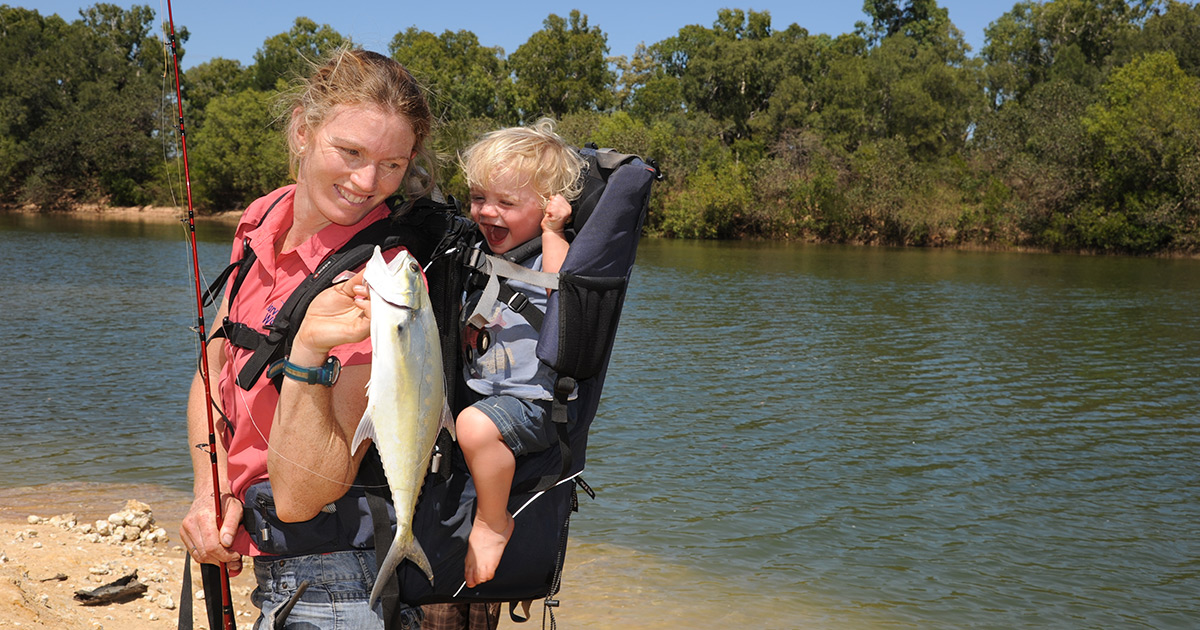
Where to Fish
There are a number of locations that are great for kids to start fishing such as a piers and jetty, the beach, lakes, dams and creeks, bays and estuaries and here is a list of easy places to start.
WHERE TO FISH
Choosing the right location can depend on a variety of factors such as where you live or are holidaying, what the weather is doing, where the fish are biting, how busy it is or perhaps the age of the children you are fishing with.
Before I take my kids and if I have never been there before, I try to Google a satellite picture of the area just so I know what it looks like, where the water is, how far it is from the car park, is there a playground or a toilet block near by. These factors can be more important to me than the amount or type of fish being caught.
With young children, I don’t want to have to walk too far from the car and if they get bored fishing, I like it when there is a bit of sand to explore or maybe a set of swings close by so I can watch one playing while the other might still be near the water. I also like areas with shallow banks because my kids love to swim and wade around so it makes it safe and easy when there is not a deep drop off.
I also avoid fishing off rocks or areas at the beach where there are strong waves or current lines because it can be risky. No matter how many fish I might see being caught in such locations, it is not worth the risk or the associated stress.
It is really important for beginners to have enough space to learn how to cast without hitting another person, or getting tangled in shrubs or nearby bushes. I like to have plenty of space between my boys so they don’t unintentionally hit one another or get their lines tangled all the time.
If it is bad weather, I reschedule for another time and choose a different activity. I also look at the wind and if it is not nice at the beach, I look for an area in an inlet or river, which might be protected from the wind.
PIERS & JETTIES
These are ideal places to start fishing with kids. Jetties are easy to get to, there is a distinguishable area between you and the water, plus you can often catch numerous species. Fish are attracted to structures like jetties and pylons, which provide both food and shelter. You can catch a mixture of surface feeders such as garfish and herring or bottom dwellers like flathead and leatherjackets. Young children can easily drop their bait to the bottom without casting. The water is generally calm so it is easy to feel a bite. Burly—a mix of bread and fish scraps used to attract fish—works well and as with most fishing, change of tide is a good time to fish.
Species: Bream, trevally, whiting, flathead, tailor, garfish, leatherjacket, squid, yellowtail
Rigs: Running sinker, paternoster, casting rig, floating single hook, squid jigs
Bait: Prawns, squid, pilchards, worms
LAKES, DAMS & CREEKS
If you don’t live close to the ocean there are plenty of freshwater options for taking kids fishing. Even small dams can house redfin, which are fun to catch and are great for dinner. Despite the fact that carp is a noxious species, kids can still enjoy winding in these fish, which can put up a good fight on light gear. If it is a bit of a trip to a river, you could always incorporate a camping trip and target trout, Murray cod or bass. You may need a fishing license, so check your State’s regulations.
Species: Trout, red fin, yellowbelly, Murray cod, Australian bass, golden & silver perch, carp (do not return carp to the water as it is a noxious species)
Rigs: Running sinker, float rigs, lures
Bait: Worms, grasshoppers, mudeyes, yabbies, woodgrubs, bardi grubs
BEACH FISHING
Watch the beach carefully and try to fish in a calm area with a channel, or adjacent to some structure. An offshore breeze can be beneficial for casting. If you have smaller children, you can always cast the rod and they can be responsible for winding in the fish and checking the bait.
The beach is an easy place for kids to learn how to cast and retrieve. A floating popper—a type of lure—is ideal for learners; they don’t sink and can be retrieved at very slow speeds. A sandy beach is great for playing games, making sand castles and swimming. Remember to keep an eye on the kids at all times and if they want to swim, wind in your line—the last thing you want is for them to become tangled.
Species: Salmon, whiting, bream, garfish, trevally, tailor, herring, flathead, mullet
Rigs: Running sinker, paternoster rig, casting rig, small metal lures or poppers
Bait: Pilchards, pipis, bluebait, whitebait, squid, prawns, fish pieces, worms
BAYS & ESTUARIES
These are excellent places for children to learn how to fish. Bays and estuaries provide relatively calm water that is usually well stocked with plenty of small, easy-to-handle fish. Estuaries are fish nurseries as they provide a good mix of food and shelter.
Species: Whiting, bream, flathead, tailor, snapper, salmon, mullet
Rigs: Running sinker, paternoster rig, casting rig
Bait: Prawns, pipis, worms; also try lures and soft plastics




